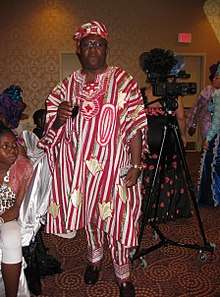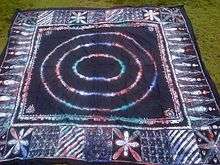Aso Oke
Aso oke fabric, (Yoruba: așǫ oke, pronounced ah-SHAW-okay) is a hand-woven cloth created by the Yoruba people of west Africa. Aso oke means "top cloth" in the English language, denoting cloth of high status.[1][2] Usually woven by men and women, the fabric is used to make men's gowns, called agbada and hats, called fila, as well as women's wrappers, called iro and head tie, called gele.


Aso oke is from the Yoruba culture in Kwara, Ondo, Oyo, Ogun, Ekiti, Lagos, and Osun States in western Nigeria and Ajase in southeastern Benin Republic.
The way of making the cloth has remained the same for centuries, however new techniques and production methods have been looked into to eliminate the weight and thickness of the aso oke cloth, and to make it more accessible for casual wear.[3]
Types of aso oke
Other ways that designers have made this old traditional cloth become more modern is to "structurally manipulate and combine animal and floral motifs into definite shapes of grids and geometry, suitable for computer design applications." The basis of more traditional motifs would have originated from fables and folklore.
- Sanyan type: woven from anaphe wild silk and cotton yarns
- Alaari type: woven with either synthetically or locally grown cotton and shinning threads, sometimes with perforated patterns
- Etu type: bears dark indigo colours with tiny white stripes noted for their simplicity.[4][5]
Aso oke fabric is often worn with aran, a brown velvet with concentric designs.
Yoruba women's garment
When people speak of an aso oke, they are usually referring to the traditional Yoruba women's garment, which consists of four parts:[6]
- Buba: Yoruba blouse
- Iro: wrap skirt
- Gele: head tie
- Iborun or ipele: shawl or shoulder sash
Formal wear
Yorubas around the world wear aso oke fabric for special occasions,[2] including holidays, weddings, funerals and chieftain title ceremonies. All followers of the Yoruba religion also wear aso oke fabrics and hats.
See also
- Adire: Yoruba tie-dye
- African textiles
- Aso Oke hat
- Women's wrapper
- Agbada
- Kente cloth—Woven by Ashanti people
- Barkcloth—Woven by Buganda people
References
- "Introduction to Aso oke". The African Waistcoat Company. Retrieved 13 December 2018.
- Nnadi, Chioma (6 February 2019). "This Nigerian Designer Has Naomi Campbell and Imaan Hammam Rocking His Mesmerizing Handwoven Suiting". Vogue. Condé Nast. Retrieved 8 October 2019.
- Agbadudu, A.B.; Ogunrin, F.O. (January 2006). "Aso‐oke: a Nigerian classic style and fashion fabric". Journal of Fashion Marketing and Management: An International Journal. 10 (1): 97–113. doi:10.1108/13612020610651150. ISSN 1361-2026.
- Bankole Ojo, Emmanuel (Spring 2007). "Printing Contemporary Handwoven Fabrics (Aso-Oke) in Southwestern Nigeria". Design Issues. 23: 31–39. doi:10.1162/desi.2007.23.2.31.
- Agbadudu, A.B. (2006). "Aso-Oke: a Nigerian classic style and fashion fabric". Journal of Fashion and Marketing and Management. 10: 97–113. doi:10.1108/13612020610651150 – via Emerald.
- "Aso-Oke | Heritage Aso Oke". asooke.com.ng. Retrieved 2020-05-24.


.svg.png)